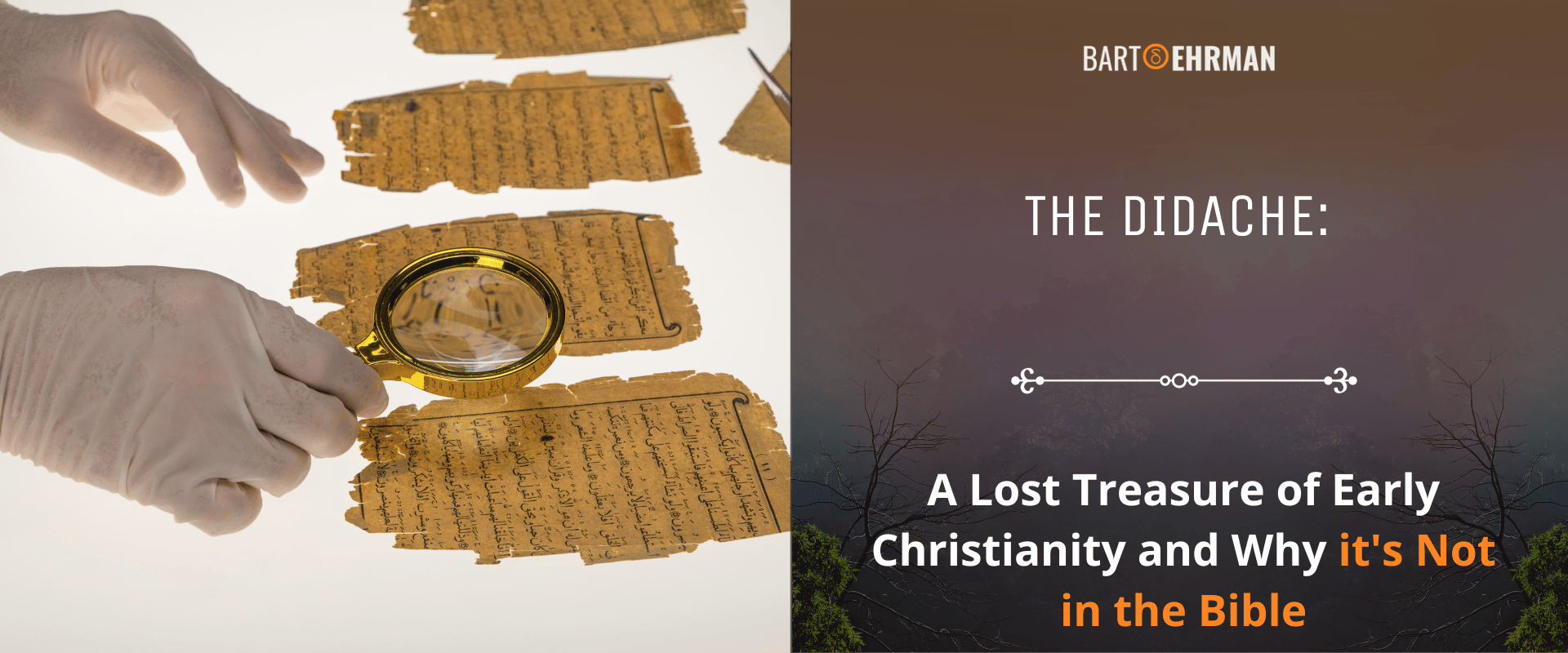The Didache: AUTHOR, DATES, and Why it's Not in the Bible

Written by Joshua Schachterle, Ph.D
Author | Professor | Scholar
Author | Professor | BE Contributor
Verified! See our editorial guidelines
Verified! See our guidelines
Date written: October 20th, 2023
Disclaimer: The views and opinions expressed in this article belong to the author and do not necessarily match my own. - Dr. Bart D. Ehrman
Have you ever heard of the Didache (pronounced DID-uh-kay)? It’s an important early Christian text that was ultimately left out of the New Testament. Nevertheless, it’s fascinating as a window into an early form of Christianity.
It is also a very Jewish document, written well before Judaism and Christianity diverged. In this article, I’ll introduce you to this text and what scholars know about it.

What does Didache mean?
The word Didache means “teaching” in Greek. Actually, the full name of the text is “The Teaching of the Lord through the Apostles to the Nations.”
While there were clearly gentiles admitted to the Didache community, there would be no need to mention them if the community itself were solely comprised of gentiles.
AUTHORSHIP: Who Wrote the Didache?
Like our four canonical Gospels, the Didache was written anonymously. However, we can deduce some things about the author (or authors) from the writing itself.
The Didache is a kind of manual for a community of Jewish Christians. In fact, there are many themes in this document that parallel the writings of the Hebrew Bible and other early Jewish sources.
For example, the first part of the text, The Two Ways Discourse, writes “There are two ways: one of life and one of death – and there is a great difference between the two ways.” This two-ways idea is found in Deuteronomy, but it’s also found in the Dead Sea Scrolls, written around the 1st century CE by Jewish separatists called the Essenes living in the Palestinian desert. This idea is clearly a part of broader Jewish thought around the time of Christianity’s founding.
The ethical teachings of the Didache also have parallels in other Jewish sources. For example, the Didache says “speak well of the ones speaking badly of you, and pray for your enemies, (and) fast for the ones persecuting you” (Did. 1:3) Similarly, in Proverbs 24:17 we read “do not rejoice when your enemies fall, and do not let your heart be glad when they stumble.”
Finally, the Didache lists the ten commandments from Exodus 20. There can be little doubt that this is a Jewish text.
And yet, Jesus is clearly important for this community as well.
FREE COURSE!
WHY I AM NOT A CHRISTIAN
Raw, honest, and enlightening. Bart's story of why he deconverted from the Christian faith.
Over 6,000 enrolled!
Christology: Who Was Jesus for the Didache Community?
There are three explicit references to Jesus in the Didache. These show us the Didache community’s Christology, their view of the nature, role, and person of Jesus.
Remarkably, in two of these references, Jesus is called God’s servant rather than God’s son. Scholars would call this is a low Christology. A high Christology, on the other hand, would mean that Jesus is equal to or one and the same with God, much as we find in the Gospel of John.
The double reference to Jesus as God’s servant in the Didache makes Jesus’ status equivalent to that of the ancient Hebrew prophets without calling him divine. Jesus is God’s chosen one and yet fully human in the Didache.
It is important to note here as well that the Didache contains no mention of Jesus’ death or resurrection, even in the prayers for the Eucharist (or Communion). This serves to underscore even further the low Christology within this community: what matters about Jesus are his teachings and example.
DATING: When Was the Didache Written?
Most scholars agree that the Didache was written in stages and later compiled into one document.
Dating the individual fragments has proven difficult if not impossible. However, scholars have dated the final version of the text. Shawn Wilhite notes that the broad scholarly consensus is that this final version was completed in the late 1st or 2nd centuries CE.
The Didache shares a lot of material with the Gospel of Matthew, written between 80-85 CE, especially sayings from the Sermon on the Mount. There are sometimes subtle linguistic differences, though. The saying “Do not give what is holy to dogs” (Did. 9:5 and Mt. 7:6) is exactly the same in both texts. However, look at this parallel:
Matthew 5:39 | Didache 1:4 |
|---|---|
But if anyone strikes you on the right cheek, turn to him also the other. | If anyone should give you a strike on the right cheek, turn to him also the other, and you will be perfect. |
The idea is undoubtedly the same, although the wording is slightly different. Clayton Jefford says that the most reasonable assumption to make is that both Matthew and the Didache got their material from the same source rather than one depending on the other.

Why Is the Didache Not in the Bible?
Some early Christians thought the Didache should be included in the New Testament. While there are no definitive reasons why it was ultimately excluded, scholars point to several possible answers.
First, as I pointed out before, it shares a lot of material with Matthew. It is possible that some Christians thought that it was redundant for that reason.
A well-known 4th-century bishop named Athanasius formed a canon list that roughly corresponded to our modern biblical canon. However, there were a few books, the Didache among them, that he said weren’t sacred scripture, although they useful for Christians to read. So while the Didache wasn’t forbidden, this was still a significant downgrade in status.
Additionally, by the 4th century when many people were trying to decide which books should be included in the Bible, the Council of Nicaea was convened, defining the position of orthodoxy for the Roman Empire at the time.
Much of what these orthodox Christians believed was not included in the Didache, including the importance of Jesus’ death and resurrection and the traditional interpretation of the Eucharist meal as Jesus’ body and blood. It’s possible, then, that without those elements, church fathers saw the book as outside the orthodox position.
Finally, there is a less appealing possibility. By the 4th century when many decisions about the biblical canon were made, a significant division had grown between Christianity and Judaism. It is entirely possible, then, that for gentile Christians, the book was too Jewish, failing to explicitly separate Judaism and Christianity.
Conclusion: What is the Didache?
The Didache is an early Jewish Christian text. It gives us a window into a community where Christianity and Judaism were not seen as separate. As such, it also shows us views about Jesus and the Eucharist that are different from what we see in the canonical Gospels.
Much of the text is practical. It tells community members how to live, how to worship, how to baptize, etc. The author or authors of the Didache wrote for their Jewish Christian community, although some gentiles were clearly included. Unlike the Nicene Creed, however, it is generally not a list of beliefs but rather a list of practices for the community to follow.
The Didache’s final form was probably compiled in the late 1st or early 2nd century. This is important because it shows us that there were many different forms of Christianity from a very early historical moment.
It didn’t adhere to 4th-century orthodoxy as outlined by the Council of Nicaea. This may be one reason why the Didache was left out of the New Testament canon. In addition, the material it shares with Matthew may have made it redundant, and it may have seemed more Jewish than some 4th-century Christians wanted.
FREE COURSE!
WHY I AM NOT A CHRISTIAN
Raw, honest, and enlightening. Bart's story of why he deconverted from the Christian faith.
Over 6,000 enrolled!
